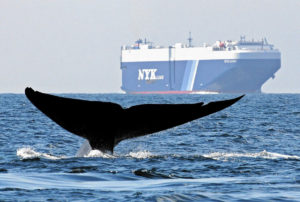Between handing out crackers to those passengers still holding on and towelettes to those who had just succumbed, the cheerful lady in the pink fleece jacket was keeping pretty busy. I tried a cracker, but it was too late, and I gave in as well to the relentless swells. But great things come at a price, and the sight of 45-foot-long humpback whales exploding head first out of the water qualifies as great in my book. And that was just one of the highlights of a recent excursion out the Golden Gate with the Farallones Marine Sanctuary Association.
The rugged beauty of our coast is undeniable. But, unlike our southern neighbors, we don’t make the ocean the focal point for our recreation. The Northern California version of “California Dreamin'” is not about beaches and surfer dudes: The water is too darn cold, and the persistent fog favors fleece over bikinis.
Yet the very factors that make the beach less alluring to us make our ocean waters irresistible to marine life, producing one of the greatest wildlife spectacles on earth. As described in our special ocean section, winds and currents from Alaska drive the upwelling of cold, nutrient-rich waters, feeding a remarkable array of wildlife, from the smallest creatures on the planet (phytoplankton) to the largest (blue whales).
Plunked down in the middle of these currents are the Farallones, stark outposts 28 miles off the Golden Gate that provide just enough real estate for the West Coast’s largest gathering of seabirds and marine mammals. Before my first trip, I had no idea that the ocean, appearing so cold and forbidding from shore, could be so alive. Even before you get to the islands, you see hundreds of common murres bobbing on the waves, dozens of shearwaters skimming the surface, and pods of sea lions swimming to the islands, which soon appear as spectral forms out of the fog.
During the summer nesting season, the first thing that hits you is the powerful stench and cacophonous shrieking produced by thousands of murres, gulls, cormorants, puffins, and pigeon guillemots, all crammed onto 211 acres of bare rock. Add the barking of sea lions, the spouting of humpbacks, the acrobatic leaping of dolphins, the wheeling and diving of pelicans over schools of anchovies, and the occasional shark attack, and you’ve got a memorable case of sensory overload that more than compensates for a bit of queasiness.
Back on solid land, engulfed by the city’s familiar yet less primal sensory overload, I struggle to integrate the experience of a world so different from the one I live in, yet so close and so connected. It is, of course, not a world for humans; we evolved to live on land. And yet, despite the ocean’s vastness, what we do here has a huge impact there. Reducing the killing of whales was a good first step. Now we need to stop the polluted runoff, oil spills and drilling, overfishing, sonar testing, etc., so that the whales we “saved” have a healthy ocean to live in and leap out of from time to time, to the delight of the occasional awed human visitor. You can both see and save the whales, and their many marine brethren, by checking out the organizations listed in our ocean resources list.

.jpg)



